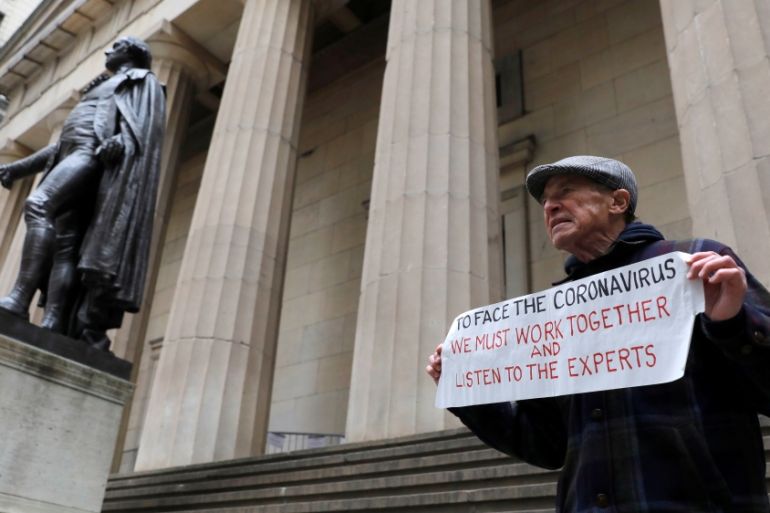US stocks close higher, but rally lost steam on stimulus haggling
Dow was up more than 1,100 points, but rally faded on news of potential delays with $2 trillion virus relief bill vote.

United States stock markets posted their first back-to-back gains since early February, but the rally lost steam near the close of trading as Senate Republicans and Democrats appeared to be at loggerheads over portions of a blockbuster $2 trillion aid package to help counter the economic damage spawned by the coronavirus pandemic.
The Dow Jones Industrial Average closed up 495.64 points, or 2.39 percent. It had been trading nearly 1,200 points higher only 15 minutes from the market close.
Keep reading
list of 3 items70 percent of G7 households expect to be made poorer by virus
Rebound! Dow closes up 2,100 points – biggest gain ever
But the rally faded as news surfaced of potential stumbling blocks to passing the stimulus bill quickly in the Senate.
Republican Senators are reportedly taking issue with language in the bill surrounding enhanced unemployment benefits for Americans. Democratic presidential candidate Senator Bernie Sanders tweeted that unless Republicans dropped their objections, he is “prepared to put a hold on this bill until stronger conditions are imposed on the $500 billion corporate welfare fund”.
The broader S&P 500 index – a proxy for US retirement and college savings accounts – finished the session more than one percent higher. But the Nasdaq Composite Index dipped into negative territory to close down 0.45 percent.
Wednesday’s bounce in the Dow and S&P extended a blockbuster rally on Tuesday that saw the 30-share Dow post its best one-day point gain ever and its biggest percentage gain since 1933.
Leading the Dow higher were shares of aerospace giant Boeing, which gained 24.3 percent.
But the choppy trading session suggests many investors are unsure of whether the stimulus bill expected from Washington will be enough to offset the blow coronavirus is delivering to the US economy.
Markets are bracing for initial weekly jobless claims data that will drop on Thursday. Expectations are that millions of American filed for unemployment insurance last week as coronavirus containment measures shuttered businesses, triggering massive layoffs.
The $2 trillion package is designed to provide aid to industries, businesses and individuals as well as state and local governments struggling to cope with the fallout from coronavirus as it sweeps across the nation.
The bill is expected to include a $500bn fund to help industries such as airlines that have been ravaged by coronavirus disruptions. American families could receive up to $3,000 in direct cash payments depending on their household income and whether they have children.
The bill may also include $350bn to provide loans to small businesses, $250bn for expanded unemployment aid and $150bn for various healthcare initiatives, including $100bn for hospitals and related health systems.
The fiscal stimulus would come on the heels of unprecedented, historic actions by the US Federal Reserve to ease dollar shortages as businesses and investors scramble to get their hands on enough cash to weather the coronavirus storm.
The Fed has slashed interest rates to near zero, injected trillions of dollars into credit markets to keep them from freezing up and made trillions more available. It has also innovated new measures to shore up the US economy.
On Wednesday, former Fed Chairman Ben Bernanke, who stewarded the US economy through the 2008 financial crisis by innovating bold, never-before-tried policies, praised current Fed Chair Jerome Powell and his team, telling business news network CNBC that they have been “extremely proactive” and “got ahead of this”.
Bernanke also put the current slowdown into perspective, telling CNBC that the current shock the US economy is experiencing from coronavirus is “much closer to a major snowstorm or a natural disaster than it is to a classic 1930s-style depression”.
Meanwhile, analysts continue to revise forecasts for the US economy as the damage from coronavirus becomes clearer. Capital Economics now sees second-quarter US economic growth plunging 40 percent from a year earlier and unemployment spiking to 12 percent.
“Admittedly, our forecast is slightly more pessimistic than other US forecasters [at least today], but it is broadly in line with the impact we expect in other countries,” Capital Economics Chief US economist Paul Ashworth wrote in a note on Wednesday. “We’re not trying to attract attention with it, this is just where a dispassionate analysis takes us.”